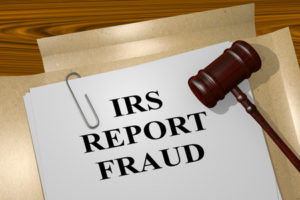
58981183 – 3d illustration of “irs report fraud” title on legal documents. legal concept.
If you are self-employed and recently received an examination notice from the Internal Revenue Service or are have concerns about the manner in which you have been operating your business, you may find the following discussion helpful. For purposes of this discussion, the term “self-employed” will include sole proprietorships, single member LLC’s, Sub Chapter S. Corporations as well as C Corporations.
Individuals who elect to go into business for themselves will typically seek out the assistance of an attorney who may or may not be familiar with the U.S. Tax Laws. Others may elect to use services such as “Legal Zoom” for purposes of setting up a corporation or Limited Liability Company. In both instances, the focus is usually on the issue of limited liability for the organizer and very little discussion on the subject of tax compliance.
Consequently, some Individuals who are self-employed see the business as a personal war chest to be used to fund lavish vacations or to purchase luxury items, such as homes, jewelry, and let us not forget the exotic automobiles. If the self-employed individual has an affinity for fine food and wines, he may also determine he is entitled to write off all of his meals. After all, his is the business and without him, none of this would be possible.
Some are even so brazen as to place family members who perform no services on behalf of the business on the payroll. In one extreme case, a taxpayer built a 3,000 square foot garage to house his exotic vehicles and depreciated the cost of the garage valued at over $200,000. This individual also wrote off the exotic vehicles. The other schemes include using business revenues to fund lavish events such as a daughter’s wedding or a golf outing or deducting payments for personal services such as house cleaners, nannies and the like.
Where the business structure is either a C or S Corporation or a multi member limited liability company, there may be less transparency than in the case of a sole proprietorship or single member Limited Liability Company. Nevertheless, there is always exposure.
The individual’s tax problems usually begin to surface following a downturn in business, a divorce, a business breakup, a disgruntled former employee, a formal filing (Bankruptcy) or default on a loan when the taxpayer’s nefarious actions may be unmasked. It is very rare that tax evasion schemes are carried out without the assistance or at least, the knowledge of others and are usually accompanied by some form of financial representation that is inconsistent with the income that is reported.
When a business begins to struggle, the self-employed individual usually engages in fiscal austerity measures which may include not paying employment taxes to the IRS, failing to make quarterly installment tax payments, failing to remit state sales tax or failing to pay vendors.
However, that is where the austerity usually begins and ends. As financial pressures mount, the individual may decide to transfer personal and corporate assets to a newly created nominee entity, a trust or to family members or friends with the hope of keeping these assets beyond the reach of the IRS. In the case of substantial unpaid payroll taxes, the individual may sometimes form a new entity for purposes of avoiding the outstanding payroll tax liability but continuing the business. This process if repeated is known as “Pyramiding.”


